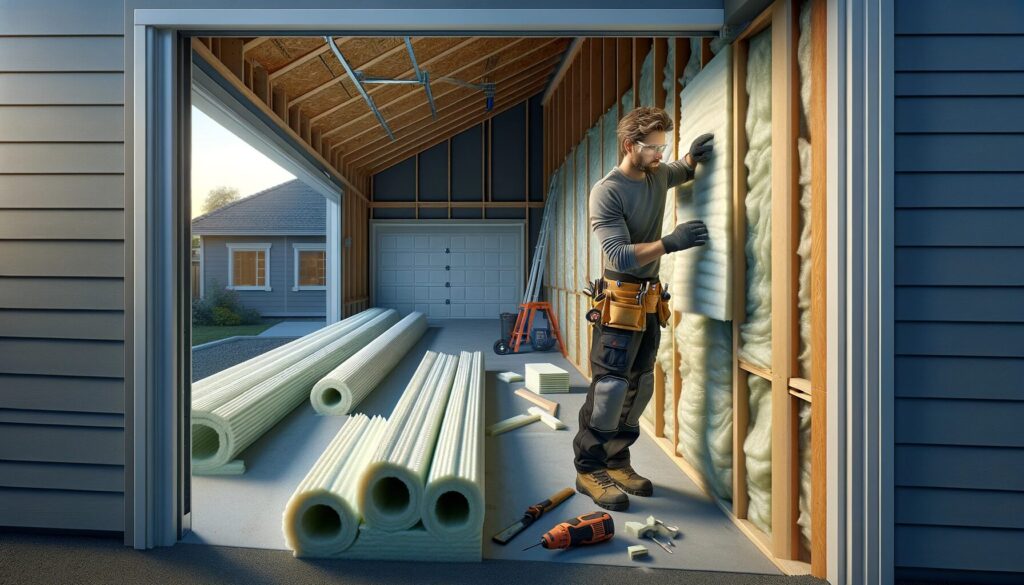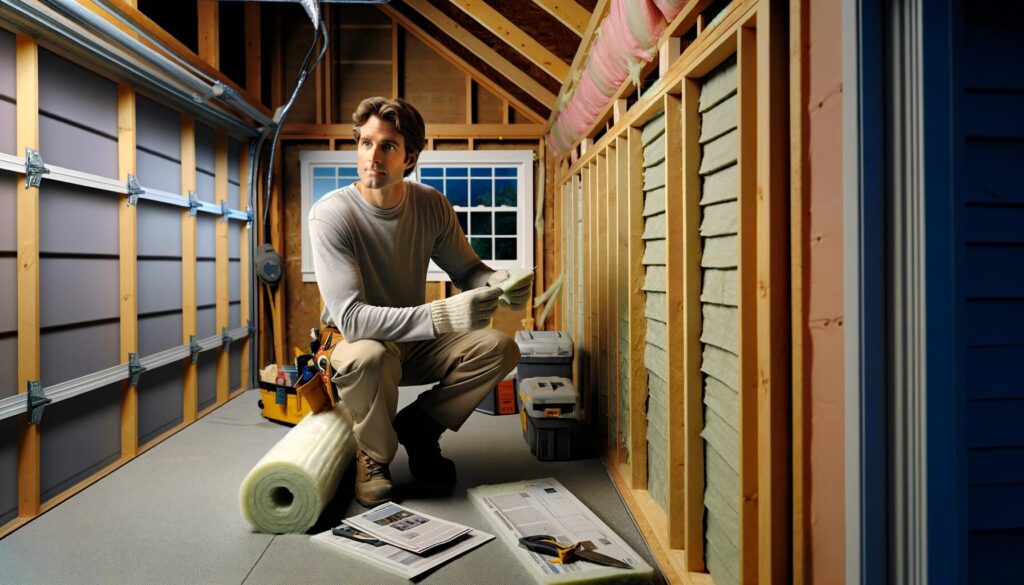Tackling garage insulation might not be the first project on your list, but let me tell you, it’s a game-changer for any home workshop. In my years of renovation, I’ve seen garages transformed from chilly, uninviting spaces to cozy, efficient work areas just with proper insulation. Let’s dive into why this project is a must for any home handyman or self-employed construction pro.
- Energy Efficiency: This isn’t just about comfort, it’s about cost-efficiency. Proper insulation keeps your energy bills down by maintaining stable temperatures, whether it’s the heart of winter or the peak of summer.
- Temperature Control: Your garage should be a workspace that’s comfortable year-round. Insulation makes that a reality, keeping the cold out and the heat in, or vice versa.
- Noise Reduction: Insulation serves a dual purpose – it also acts as a sound barrier, keeping external noise out and the peace in, which is crucial if you’re working on projects that require concentration.

Garage Insulation 101
In my many years on the job, I’ve seen all sorts of approaches to insulation. Here’s the lowdown on what you need to know to get it right.
What’s Garage Insulation All About?
- Insulation is your garage’s shield against the elements, maintaining a comfortable working environment and reducing energy costs.
- It’s not just about staying warm, it’s about creating a usable space all year long.
Types of Insulation Materials for Garages
- Fiberglass: Common and cost-effective, but handle with care – those fibers can be a nuisance.
- Foam Board: Great for tight spaces with its slim profile and impressive insulating properties.
- Spray Foam: It’s the top-tier choice for sealing every gap, though it comes at a higher cost and might need professional application.
Understanding R-Values
- Think of R-value as the effectiveness rating of your insulation. Higher values mean better insulation.
- Garages typically need higher R-values due to less robust construction compared to the rest of the house.
Insulating Garage Walls: A Step-by-Step Guide
Now, let’s get down to the nitty-gritty of insulating those garage walls. It’s a straightforward process, but attention to detail is key.
Step-by-Step Insulation Guide
- Measure Up: Start by getting the precise dimensions of your walls. This determines how much insulation you’ll need.
- Prep the Walls: Ensure the walls are clean and free from any debris or old insulation.
- Cutting to Size: Use a utility knife for precise cuts, whether it’s fiberglass or foam board, to fit the insulation between the studs.
- Installation: Install the insulation securely. With fiberglass, staple it into place. Foam boards can be adhered or fastened with screws.
Choosing the Right Material
- Consider your budget and requirements. Fiberglass is economical, foam boards are slim and efficient, and spray foam offers the best coverage but at a higher cost.
- Also, think about the activities in your garage. If you’re doing a lot of woodwork or using heavy machinery, fire-resistant materials should be your go-to.
Vapor Barrier Importance
- Vapor barriers are crucial in preventing moisture build-up, which can lead to mold and structural damage.
- They should be installed on the interior side of the wall in colder climates to prevent indoor moisture from seeping into the insulation.
Garage Ceiling Insulation Techniques
When we turn our attention to the garage ceiling, we’re hitting a critical area for thermal efficiency. This is particularly vital if there’s a living space above. Just like heat rises, so do your heating costs if this area isn’t properly insulated.
- Preventing Heat Loss: Much like heat escaping a house through an uninsulated attic, your garage ceiling can be a major culprit for energy loss. Insulating it is akin to putting a lid on your energy costs.
- Enhancing Energy Efficiency: With the right insulation, your garage becomes more than just a storage space, it transforms into an energy-efficient part of your home.
Choosing the Right Insulation
- Fiberglass Batt Insulation: Commonly used due to its ease of installation. It’s simple to roll out between joists, though care must be taken to avoid leaving gaps.
- Blown-In Insulation: Perfect for those tricky areas with lots of crannies. It requires some equipment but is unbeatable for filling in every gap.
- Rigid Foam Insulation: A go-to for a neat finish. It’s easy to cut and fit, offering excellent insulation with minimal space usage.
Overcoming Challenges in Garage Ceiling Insulation
- Dealing with Uneven Surfaces: In garages with irregular ceiling surfaces, spray foam or blown-in insulation can adapt to the contours, providing a seamless insulating layer.
- Working in Tight Spaces: High R-value materials like polyisocyanurate (polyiso) boards are thin yet highly effective, ideal for spaces where every inch counts.

Insulating Garage Doors
Moving on to garage doors, a key element often missed. Insulating them is as crucial as any other part of your garage for maintaining a consistent temperature.
Why Insulate Garage Doors?
- Completing your garage’s insulation envelope is essential. An uninsulated door is like having an open window in a heated room – it defeats the purpose of the other insulation you’ve installed.
Insulation Options for Garage Doors
- Insulation Kits: These handy kits come ready to install and are a straightforward weekend project.
- DIY Solutions: For those who prefer a custom approach, using cut-to-fit foam board or fiberglass offers a personalized insulation solution.
Maintaining Insulated Garage Doors
- Inspection Routines: Regularly check the insulation for signs of wear or damage, particularly after extreme weather conditions.
- Seal Maintenance: Ensuring that the door’s seals are intact is crucial to prevent drafts and maintain insulation effectiveness.
Ventilation and Moisture Control in Insulated Garages
Lastly, a well-insulated garage needs proper ventilation to prevent moisture-related issues and ensure good air quality.
The Necessity of Garage Ventilation
- Moisture Management: Without adequate ventilation, moisture can accumulate, leading to mold and wood rot.
- Air Quality Assurance: Good ventilation is essential to prevent the buildup of harmful fumes or dust, particularly in a workspace.
Moisture Prevention Strategies
- Adequate Ventilation: Installing vents or an exhaust fan can significantly improve air circulation, preventing moisture stagnation.
- Using Dehumidifiers: In humid climates or tightly sealed garages, a dehumidifier can be an effective tool to control moisture levels.
Ensuring Good Air Quality
- Ventilate When Possible: Open doors and windows periodically to allow fresh air to circulate.
- Consider Air Purifiers: If you’re working with materials that generate dust or fumes, an air purifier can be a beneficial addition to maintain a healthy working environment.
By following these insights, your garage can achieve the perfect balance of being well-insulated, moisture-controlled, and ventilated, making it an efficient and pleasant space for any project.
Cost Considerations and DIY vs. Professional Installation
In the realm of garage insulation, understanding the financial implications is as crucial as the project itself. Let’s break down the monetary aspects and weigh the options between DIY and professional installation.
Deciphering the Costs
- Material Expenses: Your choice of insulation material will significantly influence your budget. Fiberglass batts are generally more affordable, while spray foam, though pricier, offers superior insulation.
- Tools and Equipment: If you opt for spray foam, remember to factor in the cost of renting application equipment.
- Additional Supplies: Items like vapor barriers, sealants, and adhesives also add to the overall cost, so plan accordingly.
DIY Versus Professional Installation
- DIY Benefits: Tackling the job yourself can cut costs substantially. It’s also a gratifying way to gain hands-on experience.
- DIY Drawbacks: The risk of incorrect installation looms large, potentially leading to higher costs or inefficiencies in the future.
- Professional Pros: Hiring experts brings in a level of precision and efficiency, backed by experience.
- Professional Cons: The primary downside is the higher initial outlay for their services.
Smart Budgeting Strategies
- Shop Around: Comparing prices for both materials and professional services can yield significant savings.
- Future Savings: Investing a bit more initially for quality installation or materials can result in long-term financial benefits through energy savings.
Common Mistakes to Avoid in Garage Insulation
Having seen a fair share of garage insulation projects, I can tell you that certain missteps are common but avoidable.
Typical DIY Insulation Errors
- Ignoring Gaps: Even small gaps can significantly undermine the insulation’s effectiveness.
- Misjudging R-Values: Selecting the appropriate R-value for your specific climate is crucial.
- Faulty Vapor Barrier Installation: An improperly installed vapor barrier can lead to moisture problems, a common oversight in DIY projects.
Prevention and Correction
- Accuracy in Measurement: Ensuring precise measurements and cuts is key to effective insulation.
- Educate Yourself: Research and understand the specific needs of your garage space to make informed material choices.
- Seek Expertise When Needed: Don’t hesitate to consult a professional if you find yourself out of your depth.
FAQ Section
Insulating your garage is definitely within the realm of a skilled DIYer, particularly for simpler projects. However, for more complex jobs, or if you’re uncertain about your abilities, hiring a professional ensures a thorough and efficient job.
The ideal insulation type depends on your garage’s structure and your specific needs. Fiberglass batts are widely used for their ease and cost-effectiveness. However, for irregular spaces or higher efficiency, options like spray foam or blown-in insulation might be more suitable.
Indicators that your garage may need additional insulation include noticeable temperature shifts within the garage, increased energy bills, or drafts. These signs suggest that the existing insulation is insufficient.
Yes, insulation is beneficial even in unheated garages. It helps in maintaining a more consistent temperature, protecting stored items from extreme cold or heat, and can improve the overall energy efficiency of your home.
Certainly. Insulation serves as an effective sound barrier, reducing the transmission of external noise into the garage and vice versa. This is particularly beneficial if you use power tools or other noisy equipment in your garage.
